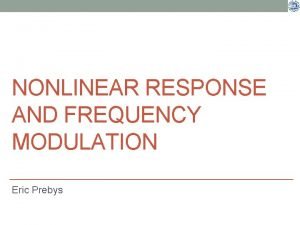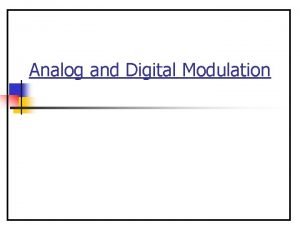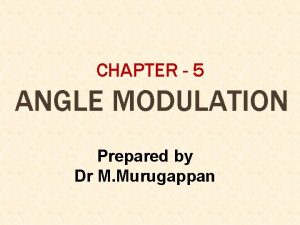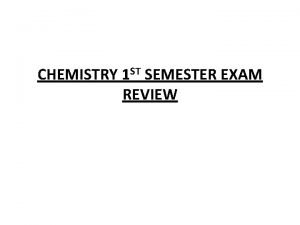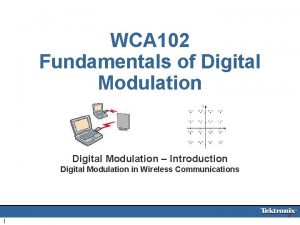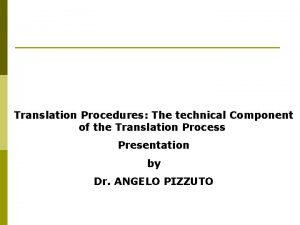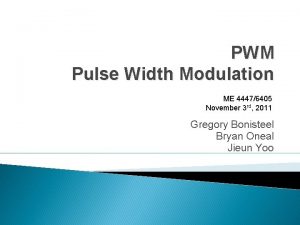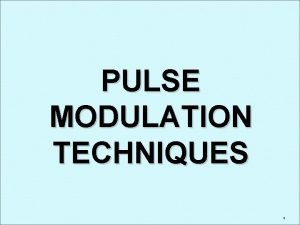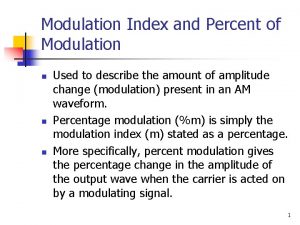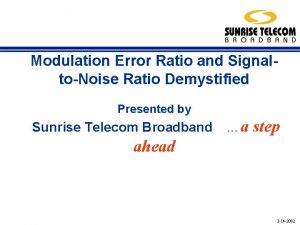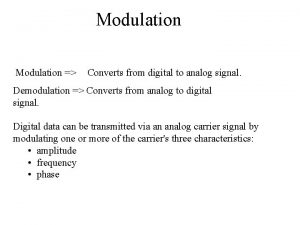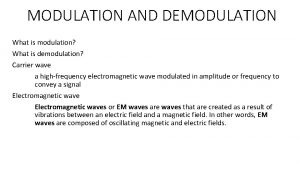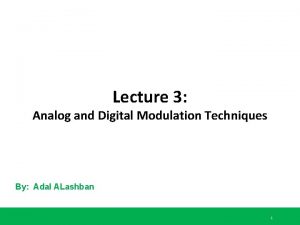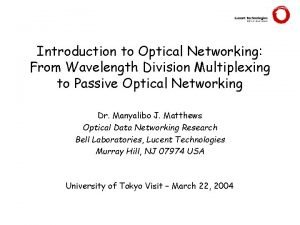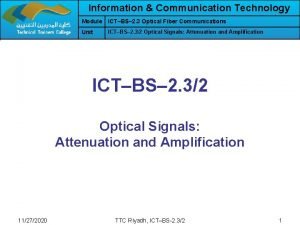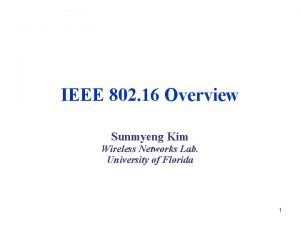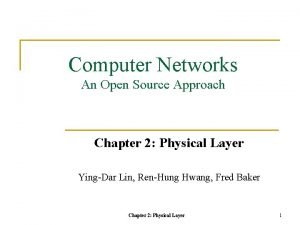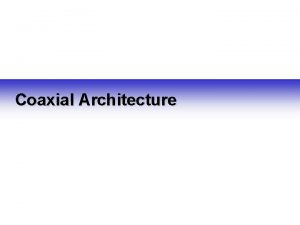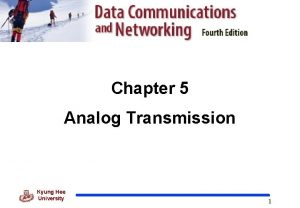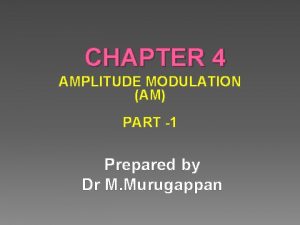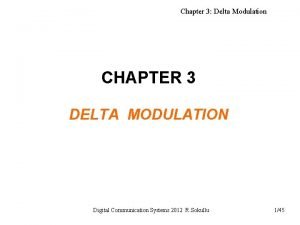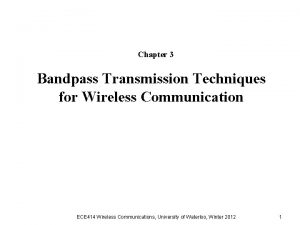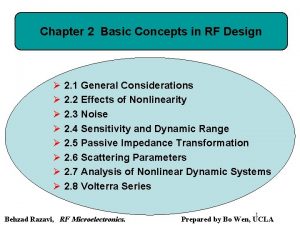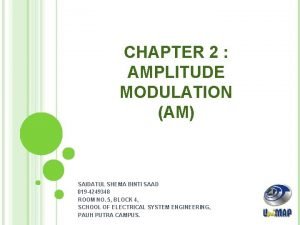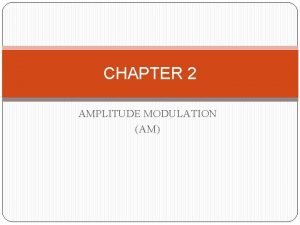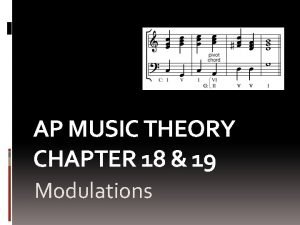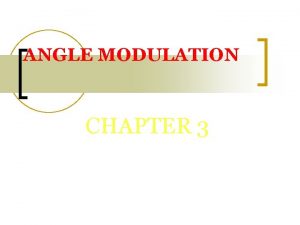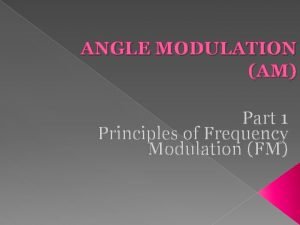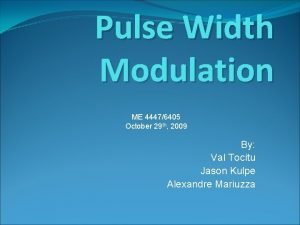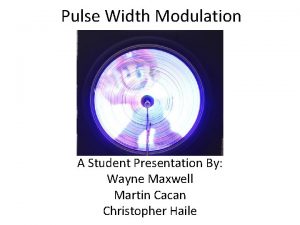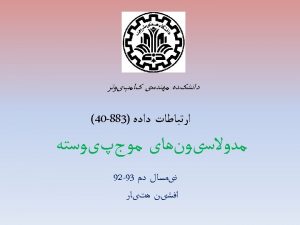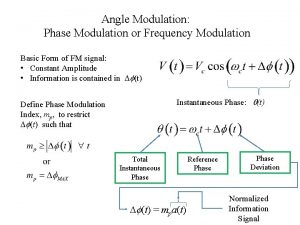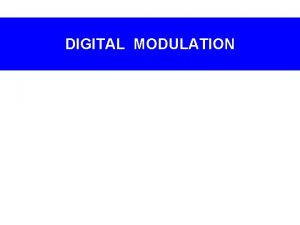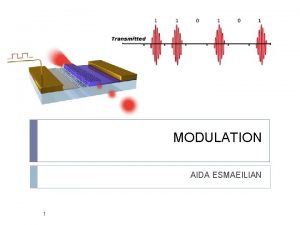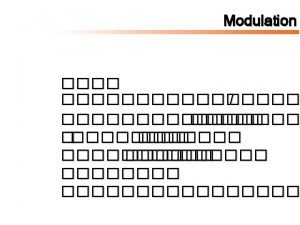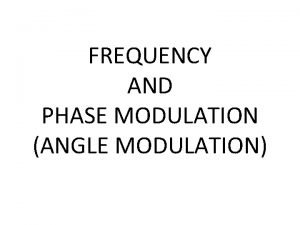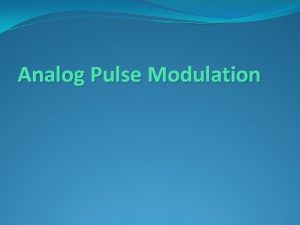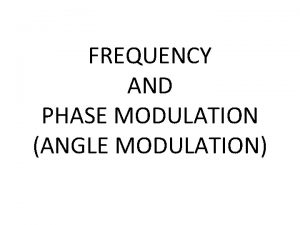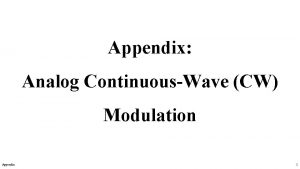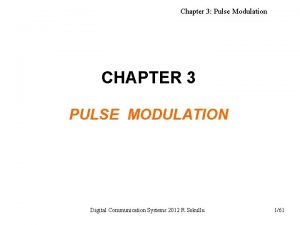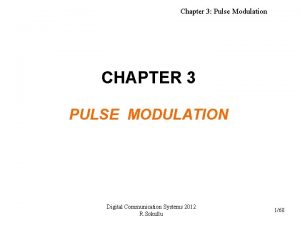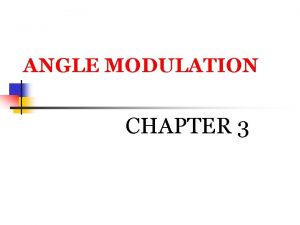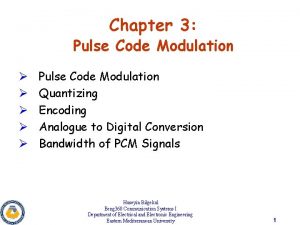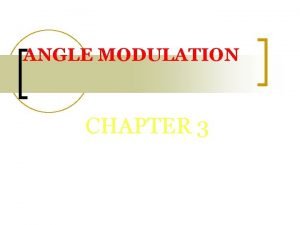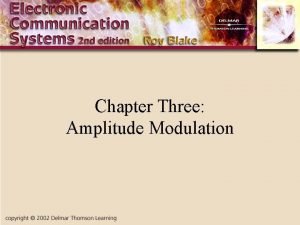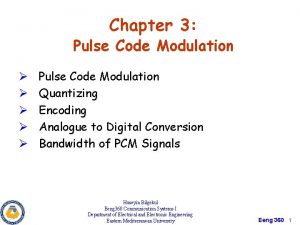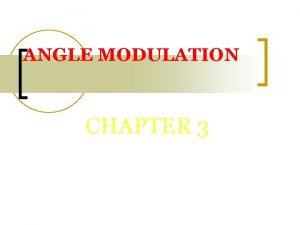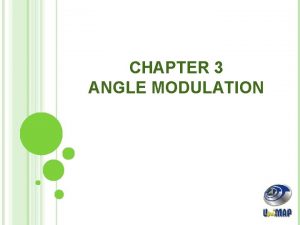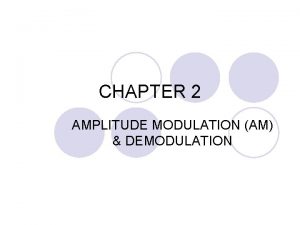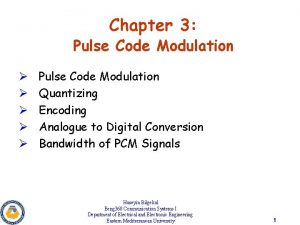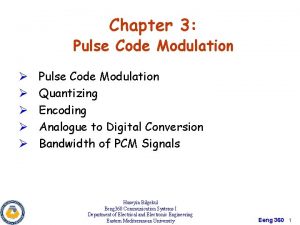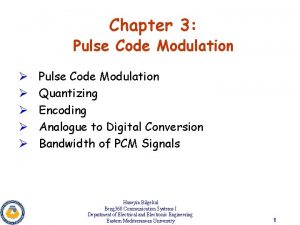1 CHAPTER 4 CONTINUOUSWAVE CW MODULATION First semester







































- Slides: 39

1 CHAPTER 4: CONTINUOUS-WAVE (CW) MODULATION First semester 1435 -1436 King Saud University College of Applied studies and Community Service 1301 CT

2 Communications System Model • A typical communication system can be modeled as Input signal Input Transducer Transmitted signal Transmitter Sender/ Transmitter Received signal Channel Distortion And Noise Output signal Receiver Output message Output Transducer Receiver Destination Source Input message

3 Introduction to Modulation • The purpose of a communication system is to deliver the input message from the source in a recognizable form to the destination over the channel. • To do this, the transmitter modifies the message signal into a form suitable for transmission over the channel. • This modification is achieved by means of a process known as modulation. • Modulation involves varying some parameter of a carrier signal in accordance with the message signal.

4 Introduction to Modulation • The receiver re-create the original message signal from a degraded version of the transmitted signal after propagation through the channel. • This re-creation is accomplished by using a process known as demodulation, which is the reverse of the modulation process used in the transmitter.

5 Introduction to Modulation • However, owing to the unavoidable presence of the noise and distortion in the received signal, we find that the receiver cannot recreate the original message signal exactly. • The resulting degradation in the overall system performance is influenced by the type of modulation scheme used. • Specifically, we find that some modulation schemes are less sensitive to the effects of noise and distortion than others

6 Modulation • In general there are two main classes of modulation: continuous -wave modulation (CW) and pulse modulation. • In CW modulation, a sinusoidal signal is used as the carrier. • When the amplitude of the carrier is varied in accordance with the modulating signal, we have Amplitude Modulation (AM). • When the frequency of the carrier is varied in accordance with the modulating signal, we have Frequency Modulation (FM). • When the phase of the carrier is varied in accordance with the modulating signal, we have Phase Modulation (PM).

7 Modulation • In pulse modulation, the carrier consists of a periodic sequence of rectangular pulses. • Pulse modulation can itself be of an analog or digital type.

8 Analog Communication System • There are two types of communication systems: analog communication system and digital communication system. • The CW modulation is used in the analog communication system. • In CW modulation, the analog baseband signal is transmitted using a high frequency sinusoidal signal. • In this system, the transmitter consists of a modulator and the receiver consists of demodulator

9 CW Modulation • The channels of communication system are either be low-pass or band-pass channels. • A low-pass channel has a bandwidth with frequencies between 0 and ��. • A band-pass channel has a bandwidth with frequency between �� 1 and �� 2

10 CW Modulation • The baseband signals produced by various information sources are not suitable for direct transmission over band-pass channels. • A baseband signal or low frequency signal is a signal whose spectrum is positioned close to dc (ω=0). Examples of baseband signals include speech signals whose spectrum occupies the frequency band 0 to 3. 5 k. Hz and video signals whose spectrum occupies the frequency band 0 to 4. 3 k. Hz.

11 CW Modulation • To perform the transmission, the sender needs to modify the baseband signal into a form that is suitable for transmission over the channel. • The modulation process cause a shift in the range of frequencies contained in the message signal into another frequency range suitable for transmission over the channel, centered onto the carrier frequency. • So, the baseband signal can be transmitted through a band-pass channel

12 Benefits of Modulation • In addition to facilitating transmission, there are some important reasons for modulation: • Ease of Radiation • Multiplexing • Reduce Noise and Interference

13 Ease of Radiation • If the communication channel consists of free space (radio channel), then antennas are needed to radiate and receive the signal. • Efficient electromagnetic radiation requires antennas whose dimensions are at least 1/10 of the wavelength of the signal being radiated.

14 Ease of Radiation • Many baseband signals, including audio signals, have frequency components down to 100 Hz or lower. For these signals, antennas about 300 km long will be necessary if the signal is radiated directly. • If modulation is used to impress the baseband signal on a high-frequency carrier, say at 100 MHz, then antennas need be in order of 30 meters.

15 Multiplexing • Consider a case of several senders want to send at the same time. • If they send the baseband signals directly, all signals at same frequencies from different senders would be mixed up. • The solution of allowing one sender to send at time is wasteful because the channel’s bandwidth my be much larger than that of the signal.

16 Multiplexing • One way to solve this problem is to use modulation. • Modulation is used to translate different signals to different frequency range by assign the carriers to different frequencies that are sufficiently far apart of each other. • This way of multiplexing called the frequency division multiplexing (FDMA). • At the received side, a tunable bandpass filter is used to select the desired signal

17 Reduce Noise and Interference • The effect of noise and interference cannot be eliminated in a communication system. • A brute-force method for combating noise and interference is to increase the signal power until it overwhelms the contaminations. • But increasing power is costly and my damage equipments.

18 Reduce Noise and Interference • Other way to minimize the effects of noise and interference is using modulation. • Certain types of modulation schemes have valuable property of suppressing both noise and interference. • These schemes generally require a transmission bandwidth much larger than the bandwidth of the modulating signal.

19 Amplitude Modulation (AM) • As the name suggests, in AM, the modulating signal varies the amplitude of the carrier sinusoid wave. • The instantaneous value of the carrier amplitude changes in accordance with the amplitude and frequency variations of the modulating signal. • The carrier frequency and phase remain constant during the modulation process, just its amplitude varies in accordance with the modulating signal.

20 Amplitude Modulation (AM)

21 Types of Amplitude Modulation (AM) • There are several different ways of amplitude modulating the carrier signal by the baseband signal ( modulating signal), each of which results in different spectral characteristics for the transmitted signal (modulated signal): • Double-sideband suppressed carrier (DSB-SC) modulation • Amplitude modulation (AM). • Single-sideband modulation (SSB). • Vestigial-sideband modulation (VSB). • Each of these schemes has its own distinct advantages, disadvantages, and practical applications.

22 DOUBLE-SIDEBAND SUPPRESSED CARRIER (DSB -SC) MODULATION • Modulation • Spectrum • Upper and Lower Sidebands • Bandwidth • Example • Demodualtion

23 Modulation • The modulating signal (information or baseband signal) • The carrier signal is • The modulated signal

24 Modulation

25 Modulation • The DSB-SC modulated signal undergoes a phase reversal whenever the message signal m(t) cross zero. Envelop phase reversal • Consequently, the envelop of a DSB-SC modulated signal is different from the message signal

26 Spectrum • The process of DSB-SC modulation shifts the spectrum of the modulating signal m(t) to the left and the right by ωc (carrier frequency). • if then

27 Spectrum

28 Upper and Lower Sidebands • The modulated signal spectrum centered at ωc is composed of two parts: a portion that lies above ωc , known as the upper sideband (USB), and a portion that lies below ωc , known as the lower sideband (LSB). • Similarly, the spectrum centered at - ωc has upper and lower sidebands. • Hence, this is a modulation scheme with double sidebands

29 Upper and Lower Sidebands ωc - ωM ω c +ω M

30 Bandwidth • If the bandwidth of the modulating signal is B Hz, then the bandwidth of the modulated signal is 2 B Hz. 2πB 2 B 2 B

31 Bandwidth • In order to avoid the overlap of the spectra centered at ωc and –ωc , the ωc should be ≥ ωM. • If ωc < ωM, the LSB of ωc will overlap with LSB of -ωc • Which make it impossible to get back the m(t) from the modulated signal m(t) cos (ωct).

32 Example • Suppose that the modulating signal m(t) is a sinusoid of the form • And the carrier signal is : • Determine • The DSB-SC signal SDSB(t) (modulated signal) • The upper and lower sidebands • The bandwidth • Sketch the spectrum of the m(t) and SDSB(t)

33 Solution • The DSB-SC signal • By using the relation • The SDSB(t) is

34 Solution • The upper and lower sidebands USB = 106+103=1001 KHz LSB = 106 -103=999 KHz • The bandwidth of SDSB(t) BW = 2 * 103 =2000 Hz = 2 KHz

35 Solution • Sketch the spectrum of the m(t) and M(ω) - SDSB(t) f 103 SDSB(ω) 1000 f

36 Demodulation • The DSP-SC demodulation consists of multiplication of the incoming modulated signal m(t) cos (ωct ) by a carrier cos (ωct) followed by a low pass filter. Modulation Demodulation • The receiver need to generate a local carrier that has the same frequency and the same phase of the carrier used for modulation.

37 Demodulation • The multiplication will shift the modulated signal spectrum to the left and to the right by ωc and multiply it by one-half. • Use a low pass filter to get the desired baseband spectrum and suppress the unwanted spectrum at + ωc and - ωc

38 modulated signal spectrum filter -2ωc -ω c ωc After multiplication 2ωc

39 Demodulation • This method of recovering the baseband signal is called synchronous detection or coherent detection, because the receiver uses a carrier of exactly the same frequency and phase as the carrier used for modulation
 Amplitude modulation vs frequency modulation
Amplitude modulation vs frequency modulation Wave modulation
Wave modulation Advantages of angle modulation
Advantages of angle modulation English 11 first semester exam
English 11 first semester exam Grade 10 biology unit 1
Grade 10 biology unit 1 Biology first semester exam study guide answers
Biology first semester exam study guide answers World history 1st semester midterm exam review answers
World history 1st semester midterm exam review answers Chemistry 1 semester exam review
Chemistry 1 semester exam review Advantages of digital modulation
Advantages of digital modulation Modulation translation
Modulation translation Tina champagne
Tina champagne Trail edge modulation
Trail edge modulation Pulse code modulation
Pulse code modulation Percentage modulation
Percentage modulation Meruuu
Meruuu Modulation digital to analog
Modulation digital to analog Modulator and demodulator
Modulator and demodulator Biomechanische prinzipien weitsprung
Biomechanische prinzipien weitsprung Digital to analog modulation techniques
Digital to analog modulation techniques Cross phase modulation
Cross phase modulation Direct modulation
Direct modulation Ssin-802
Ssin-802 Kelly's constructive alternativism assumes that
Kelly's constructive alternativism assumes that Ask modulation constellation diagram
Ask modulation constellation diagram Hfc trunks
Hfc trunks Constellation diagram bpsk
Constellation diagram bpsk Trapezoidal pattern am modulation
Trapezoidal pattern am modulation Thermal noise in analog communication
Thermal noise in analog communication Demodulation of delta modulation
Demodulation of delta modulation Ask modulation constellation diagram
Ask modulation constellation diagram Rf circuit design ppt
Rf circuit design ppt Modulation envelope
Modulation envelope Principle of am
Principle of am Monophonic modulation
Monophonic modulation Angle modulation formula
Angle modulation formula Formula for modulation index
Formula for modulation index Modulacion
Modulacion What is the modulation of severn suzuki speech
What is the modulation of severn suzuki speech Pwm modulation definition
Pwm modulation definition Duty cycle
Duty cycle
